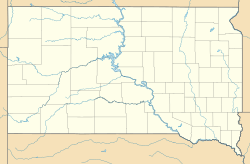Etta, South Dakota facts for kids
Quick facts for kids
Etta, South Dakota
Etta Camp, Etta Mine
|
|
|---|---|
| Country | United States |
| State | South Dakota |
| County | Pennington County |
| Elevation | 4,577 ft (1,395 m) |
| Time zone | UTC-7 (MST) |
| • Summer (DST) | UTC-6 (MDT) |
Etta, also known as Etta Camp and Etta Mine, is a ghost town in Pennington County, South Dakota, United States. A ghost town is a place where people used to live and work, but now it's mostly empty. Etta was once a busy mining town. It was famous for finding the biggest spodumene crystal ever!
Contents
The Story of Etta
Etta existed even before the nearby town of Keystone. It started as a camp for mining mica. Mica is a shiny mineral that can be split into thin layers.
From Mica to Tin
The company that started Etta was called Harvey Peak Tin Mining, Milling, and Manufacturing. They thought they were mining mica. But soon, they found out the ore was actually cassiterite. Cassiterite is a mineral that contains tin. This discovery made many new mines open up in the Black Hills area.
However, most of these new tin mines were not very successful. There wasn't a huge amount of tin in the ground. In 1883, the company built a mill and a smelter. A smelter is a place where metal is melted out of ore.
A Big Lump of Tin
During the mining, workers found a very large lump of tin. It weighed 1,200 pounds (about 540 kilograms)! Miners said it was "as big as a small boy." This huge piece of tin was shown to people in London, England. The company hoped to get more money from investors.
But the company later closed down because of a lawsuit. The mine stopped working until 1898.
The Spodumene Discovery
In 1898, the Etta mine started producing a new mineral called spodumene. Spodumene is an ore that contains lithium. Lithium is a light metal used in batteries and other things. The mine became very well known for its giant spodumene crystals.
The biggest spodumene crystal ever found in the world came from this mine!
Etta's Later Years
Until about 1900, Etta had the only post office in the Keystone area. Around that time, about 24 people lived there. In the 1920s, the mining operations were very busy and successful.
However, the mine eventually closed down in 1959. After that, the town was slowly abandoned. Today, all that is left are the foundations of the old smelter and mill. The mine itself is also still there.
Where is Etta?
Etta is located in the Black Hills of Pennington County. It is about half a mile south of Keystone. You can get there by using Glendale Road and turning south from U.S. Route 16A.


